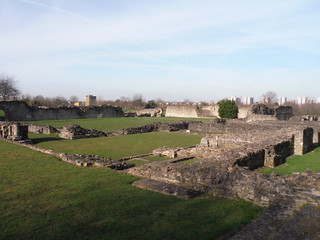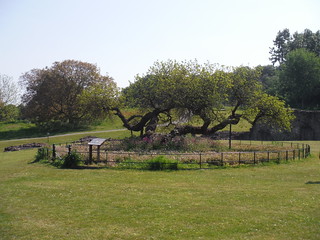| Lunch or Tea
|
Refreshments 600m off route, after 2.3 km of the route:
The Eardley Arms 44 Woolwich Road, Upper Belvedere, London DA17 5EN (01322 432 107).
The Prince of Wales 13A Woolwich Road, Upper Belvedere, London DA17 5EE (01322 433 737).
Refreshments at the end of the walk:
Chestnuts Kiosk Lesnes Abbey Lodge, Lesnes Abbey Woods, New Road, Abbey Wood, London SE2 0AX.
Abbey Café 183 Abbey Wood Road, Abbey Wood, London SE2 9DZ (020 8312 1277).
Abbey Arms 31 Wilton Road, Abbey Wood, London SE2 9RH (020 8310 1763).
Coffee House at WHSmith Abbey Wood Station, Abbey Wood.
|
| Notes |
Abbey Wood Station
Originally opened in 1849, Abbey Wood Station has been rebuilt several times to keep up with the development of the local area and the changing railway network. The last rebuild happened in preparation for the opening of Crossrail, of which Abbey Wood will be the south easterly terminus, with the refurbished station opening on 23 October 2017.
The station was also to be served by the proposed Greenwich Waterfront Transit, however the project was cancelled by the then Mayor of London due to lack of funds. A proposed extension of the Overground from Barking across the river to Thamesmead and Abbey Wood was proposed in 2015 and may yet happen, as an extension from Barking to Barking Riverside has already been confirmed. In 2016, the then Mayor also proposed a DLR extension from Gallions Reach across the river to Thamesmead and Abbey Wood.
Thamesmead
Thamesmead is an area of south-east London, straddling the border between the Boroughs of Greenwich and Bexley. It is located 18 km east of Charing Cross, north-east of Woolwich and west of Erith and mainly consists of social housing built from the mid-1960s onwards on former marshland on the south bank of the Thames. There is some evidence of prehistoric human occupation of the area: flints, animal bones and charcoal were found in bore holes. In Roman times, the river level was significantly lower, and archaeological work revealed evidence of field ditches and pottery and quern stones from Germany dating from around the 3rd or 4th century. After the Roman era, river levels rose again and the area reverted to marshland. Some areas of this marshland were drained by 1279 by the monks of nearby Lesnes Abbey.
Later, most of the land area of Thamesmead formed part of the old Royal Arsenal site that extended over Plumstead Marshes and Erith Marshes. Between 1812 and 1816, a canal was built by convicts to take materials such as timber from the River Thames to Woolwich Royal Arsenal. Much of this canal has been filled in, but part remains in Thamesmead West and is now called the Broadwater. A disused lock gate and swing bridge over the canal still exist beside the Thames.
Thamesmead as it is now was built at the end of the 1960s. Efforts were made to solve the social problems that had already started to affect earlier estates. These were believed to be the result of people being uprooted from close-knit working-class communities and sent to estates many miles away, where they did not know anybody. The design of the estates meant that people would see their neighbours more rarely than they would have done in the terraced housing that had been typical in working-class areas. The solution proposed was that once the initial residents had moved in, their families would be given priority for new housing when it became available. Another radical idea was taken from housing complexes in Sweden, where it was believed that lakes and canals reduced vandalism and other crime, mainly among the young. Water was used as a calming influence on the residents.
Thamesmead was designed around futuristic ideas, and indeed looked impressive at first from a distance. It provided walkways between its blocks of housing and later between sections in North Thamesmead, which quickly became littered and abused though, making them unsafe places to walk. Pathways set out for people to walk on were put in without regard to how people would wish to get about. The pre-1974 parts of Thamesmead are a mix of modernist town houses, medium-rise and 12-storey blocks system-built in concrete, which have featured in various films (most famously: A Clockwork Orange) due to their 'rough urban look'; the design of the newer buildings is more traditional and in brick.
One of the main problems is Thamesmead’s geographical and transport isolation: despite early proposals for the Jubilee Line Extension to go to Thamesmead, via the Isle of Dogs and the Royal Docks, it was not included and the line now heads north to Stratford, despite it also being on the Central line. The main reason cited for this decision was that many workers in Canary Wharf lived in Essex and could change from National Rail to the Jubilee line at Stratford and West Ham.
Thamesmead is also cut off from the north by the Thames and is in the centre of the 25 km gap between the Blackwall Tunnel and the Dartford Tunnel/QE2 Bridge river crossings. Various proposals have been made for a new river crossing, but all plans fell through. Since then, Thamesmead has grown significantly, limiting the number of potential sites for a new river crossing.
Existing plans for more house building will increase the total population to 80,000.
Lesnes Abbey Woods
Lesnes Abbey Woods, sometimes known as Abbey Wood, are an 88 hectares Local Nature Reserve near the ruins of Lesnes Abbey, 69 hectares of which are wood. The woods have several features dating back to the Bronze Age and a fine display of wild bluebells and native daffodils in the Spring. Part of the wood is the Abbey Wood (geological) Site of Special Scientific Interest, an important site for early Tertiary fossils, with some important Palaeocene finds, including one of only two bird fossils found from that era in Britain. Members of the public can dig for fossils in the designated Fossil Pit (with the permission of the ranger).
The very old fenced Mulberry Tree is thought to be one of the trees commissioned by James I in an attempt to set up an English silk industry. Unfortunately, the trees planted are the wrong type of Mulberry for that purpose (black rather than white). http://www.lesnesabbeywoods.org/
Local community group Lesnes Abbey Conservation Volunteers run practical conservation events to help manage the woodland. http://lesnesabbeywoods.volunteermakers.org/
Lesnes Abbey
Lesnes Abbey is a former abbey, now ruined, in Abbey Wood, in the Borough of Bexley. It is a scheduled ancient monument and was founded in 1178 by Richard de Luci, Chief Justiciar of England, as the Abbey of St Mary and St Thomas the Martyr at Lesnes. It is speculated that this may have been in penance for the murder of Thomas àBecket, in which he was involved. The abbey is situated to the north of the ancient but long-managed Lesnes Abbey Woods that are named after it, just where the land rises above what would originally have been marshland. The Abbott of Lesnes Abbey was an important local landlord, and took a leading part in draining the marshes. It never became a large community, and was closed by Cardinal Wolsey in 1525 as one of the first to be closed, under a licence to suppress monasteries of less than seven inmates. The monastic buildings were all pulled down, except for the Abbott's Lodging.
The LCC purchased the site of the ruins in 1930, which were opened to the public as a park in 1931.
The woods have several features dating back to the Bronze Age and a fine display of wild bluebells and native daffodils in the Spring. The abbey kept fishponds which were fed by a small stream running down through the woods, and these are still visible today though the water level is often low.
https://www.southlondonclub.co.uk/blog/2017/9/12/a-brief-history-of-lesnes-abbey
Green Chain Walk
The South East London Green Chain, also known as the Green Chain Walk, originally was a linked system of open spaces between the Thames and Crystal Palace Park, created in 1977 by the four boroughs of Bexley, Bromley, Lewisham and Greenwich and the GLC from 300 open spaces to protect them from building activity. The system begins at three places on the Thames: Thames Barrier, Thamesmead and Erith. There are various circular walks along the route, and there is an offshoot from the main route to Chislehurst.
More recently it has been extended to include sections in Southwark, with arms leading to Dulwich and Nunhead Cemetery. Many parts of the system are also part of the Capital Ring route.
https://tfl.gov.uk/modes/walking/green-chain-walk
Bostall Wood
Bostall Heath and Woods is an area of 159 hectares of woodland with areas of heathland, adjacent to Lesnes Abbey Woods. The area to the south of the A206 (Bostall Hill) is Bostall Woods and to the north is Bostall Heath. It consists of gorse and broom at the top of Bostall Hill, with dense woods and deep ravines on either side. During the 19th century the Heath was under threat from residential development, but the Metropolitan Board of Works and the London County Council bought up individual sections to combine them into what we see today. Bostall has various meanings, i.e. woody heath. In Sussex the term bostal is given to a steep path, particularly over the Downs.
|





